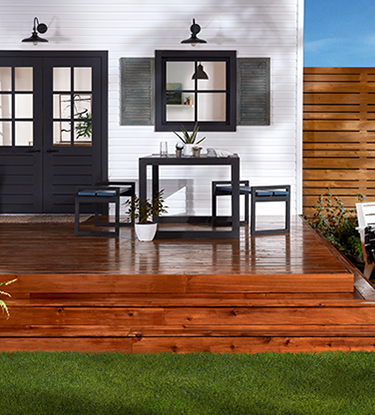Find the Right Deck Stain: Accomplish a Stunning and Sturdy Deck
Wiki Article
A Comprehensive Guide to Different Types of Deck Staining Techniques for Ultimate Protection and Visual Appeals
In the realm of deck upkeep, the art of tarnishing stands as a critical step towards both preserving the integrity of your exterior area and enhancing its visual charm. As we navigate via the detailed world of deck staining methods, one begins to appreciate the nuanced approaches that can make all the distinction in between a sub-par finish and a flawless one.Comprehending Various Sorts Of Spots
Various types of stains are typically used in the process of deck staining to achieve different aesthetic and protective impacts. On the various other hand, semi-transparent spots supply a balance in between shade improvement and protection, enabling some timber grain to reveal with.In addition, there are also specialized spots such as sealers and toners. Toners add a tip of shade to the wood while offering very little protection, making them ideal for newer decks with less wear. Sealants, on the various other hand, deal defense against moisture and UV rays without adding color, making them a prominent option for decks that currently boast a desirable shade. Recognizing the attributes and advantages of each sort of tarnish is crucial for achieving the preferred look and resilience for your deck.
Choosing the Right Spot Shade
When taking into consideration the looks of your deck discoloration job, the choice of tarnish color plays an essential role in boosting the safety qualities of the selected discolor type (Stain Deck). The shade you select can dramatically influence the general appearance of your deck, along with its ability to withstand the elements in timeWhen picking a stain color, it's important to think about the existing color pattern of your home's exterior. Integrating the deck discolor with the total visual of your home can develop a aesthetically attractive and cohesive outdoor area. In addition, the color of your deck tarnish can affect the temperature of the deck surface area; darker shades have a tendency to absorb even more warmth, while lighter colors show sunlight and stay cooler.
In addition, the kind of timber you are staining will certainly additionally influence how the stain shade appears. Different wood varieties can communicate with the stain in different means, possibly modifying the final shade. It's a good idea to test the stain on a small, unnoticeable location of the deck to make certain the shade ends up as desired prior to continuing with the entire project.
Preparing Your Deck for Discoloration
To make certain a effective and resilient deck discoloration task, complete prep work of the deck surface area is essential. Begin by cleaning up the deck thoroughly to remove dirt, grime, mildew, and any kind of old complete or tarnish. Make use of a deck cleaner or a mixture of water and cleaning agent along with a rigid brush or stress washing machine to scrub the surface tidy. After cleansing, allow the deck to dry entirely prior to relocating on to the following step.Examine the deck for any kind of Visit Your URL harmed or rotten boards that need to be replaced. Hammer down any extending nails and sand any type of rough areas to make certain a smooth surface area for discoloration. Look for any loosened barriers or actions that may need tightening or repair.
Once the deck is clean, completely dry, and in great repair service, take into consideration applying a timber brightener to bring back the deck's all-natural color and open the timber pores for much better discolor infiltration. Secure any type of neighboring plants, furnishings, or surface areas with plastic bed linen before continuing with the discoloration process. Correct preparation is crucial to achieving a professional-looking finish and maximizing the longevity of your deck tarnish.
Applying Spot With Different Techniques
For a specialist and remarkable surface, the technique of applying stain plays a vital role in enhancing the look and durability of your deck. There are numerous techniques you can utilize to guarantee an efficient application of tarnish.It is excellent for complex locations and reaching between deck boards. Back-brushing after rolling is recommended to also out the tarnish and work it right into the wood for better penetration.
Spraying is another popular strategy, offering rate and ease of application, especially for large deck areas. Whichever technique you select, ensuring correct prep work and complying with supplier guidelines will assist attain a lovely and durable discolor surface on your deck.

Preserving and Re-staining Your Deck
When it comes to re-staining your deck, the frequency depends on different aspects such as the kind of tarnish made use of, the environment in your location, and just how much wear and tear your deck experiences. Generally, it is advised to re-stain your deck every 2-4 years to keep its defense and aesthetic appeals.Prior to re-staining, make sure the deck is clean, dry, and complimentary of any type of previous discolor residue. Select a high-quality tarnish that matches your deck's material and provides the preferred level of best site defense.
Conclusion
Finally, recognizing the various kinds of deck discolorations, picking the best shade, correctly preparing the deck, using tarnish with various strategies, and re-staining the deck and preserving are crucial steps for supreme defense and visual appeals. By complying with these steps, look at this site you can make sure that your deck continues to be in leading condition for years to find.Furthermore, the color of your deck tarnish can influence the temperature level of the deck surface; darker shades have a tendency to take in even more heat, while lighter colors reflect sunshine and remain cooler.
It's suggested to evaluate the discolor on a tiny, inconspicuous area of the deck to guarantee the shade transforms out as wanted prior to continuing with the entire job.

Report this wiki page